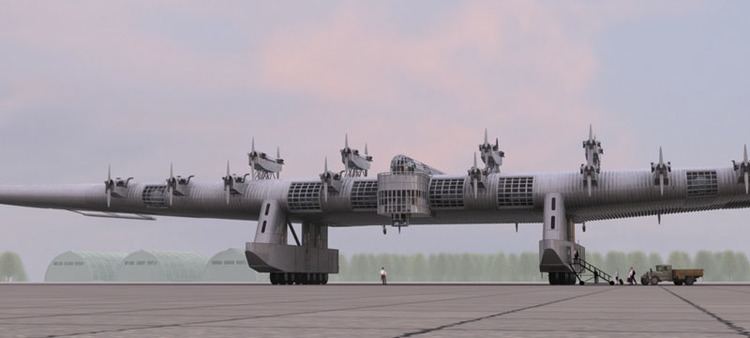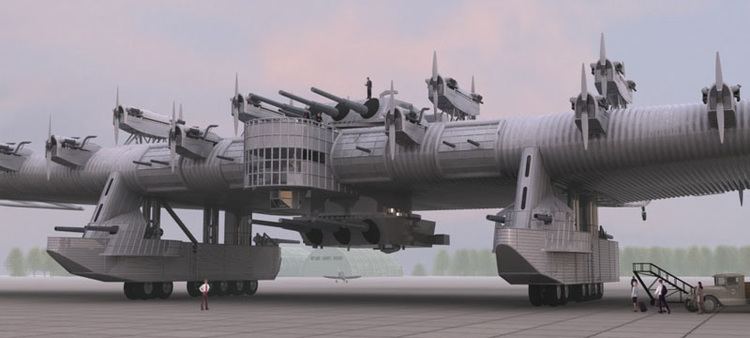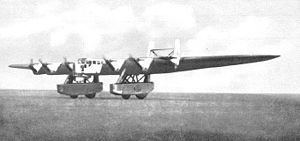Top speed 225 km/h Length 28 m Engine type Mikulin AM-34 Designer Konstantin Kalinin | Wingspan 53 m Weight 24,400 kg First flight 1933 | |
 | ||
Similar Convair XC 99, Stipa Caproni, Hughes H 4 Hercules | ||
Huge rc kalinin k 7 cccp 6m wingspan and 7 motors at kulmer air show 2014 pilot is rainer mattle
The Kalinin K-7 (Russian: Калинин К-7; Ukrainian: Калінін К-7) was a heavy experimental aircraft designed and tested in the Soviet Union in the early 1930s. It was of unusual configuration with twin booms and large underwing pods housing fixed landing gear and machine gun turrets. In the passenger version, seats were arranged inside the 2.3-meter thick (7 ft 7 in) wings. The airframe was welded from KhMA chrome-molybdenum steel. The original design called for six engines in the wing leading edge but when the projected loaded weight was exceeded, two more engines were added to the trailing edges of the wing, one right and one left of the central passenger pod. Nemecek states in his book that at first only one further pusher engine was added.
Contents
- Huge rc kalinin k 7 cccp 6m wingspan and 7 motors at kulmer air show 2014 pilot is rainer mattle
- Soviet kalinin k 7 7 huge rc model airplane scratch built
- Design and development
- Specifications K 7
- References

Soviet kalinin k 7 7 huge rc model airplane scratch built
Design and development

Designed by World War I and civil war pilot Konstantin Kalinin at the aviation design bureau he headed in Kharkiv, with a wingspan close to that of a B-52 and a much greater wing area, the K-7 was one of the biggest aircraft built before the jet age. It had an unusual arrangement of six tractor engines on the wing leading edge and a single engine in pusher configuration at the rear.

In civil transport configuration, it would have had a capacity for 120 passengers and 7,000 kg (15,000 lb) of mail. As a troop transport it would have had capacity for 112 fully equipped paratroopers. In bomber configuration it would have been armed with 8 x 20mm autocannons, 8 x 7.62mm machine guns and up to 9,600 kg (21,200 lb) of bombs.
The K-7 was built in two years at Kharkiv starting in 1931.
The K-7 first flew on 11 August 1933. The very brief first flight showed instability and serious vibration caused by the airframe resonating with the engine frequency. The solution to this was thought to be to shorten and strengthen the tail booms, little being known then about the natural frequencies of structures and their response to vibration. The aircraft completed seven test flights before a crash due to structural failure of one of the tail booms on 21 November 1933. The existence of the aircraft had only recently been announced—by Pravda, which declared it was "victory of the utmost political importance," since it had been built with USSR steel rather than imported steel. The accident killed 14 people aboard and one on the ground. Flight speculated that sabotage was suspected as the investigating committee had representation by the state security organization, the Joint State Political Directorate (OGPU).

However, there appeared recently some speculation in the Russian aviation press about the role of politics and the competing design office of Andrei Tupolev, suggesting possible sabotage. Although two more prototypes were ordered in 1933, the project was cancelled in 1935 before they could be completed.
Specifications (K-7)
Data from Shavrov (1985)
General characteristics
Performance
